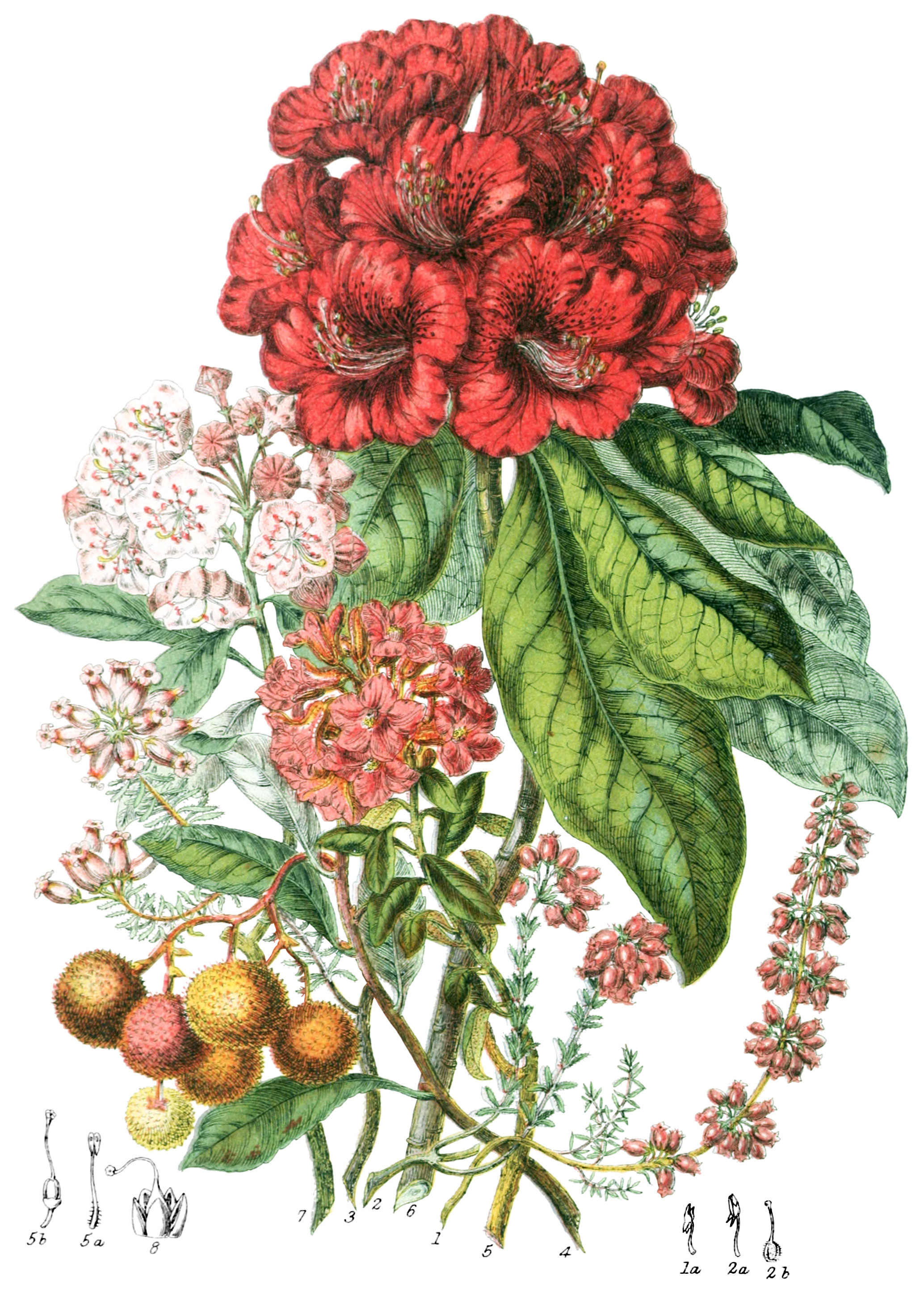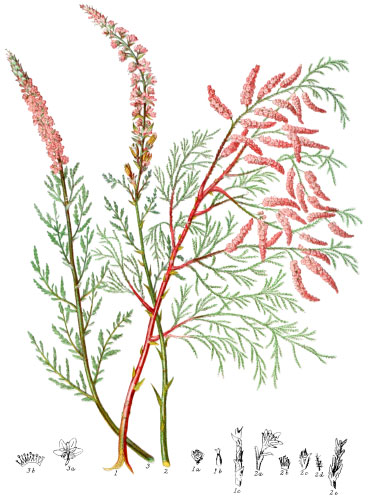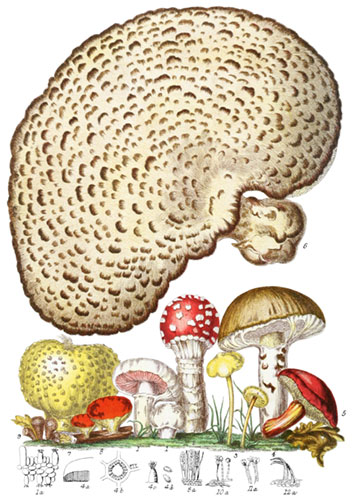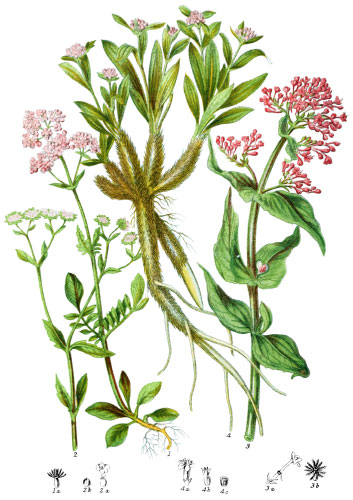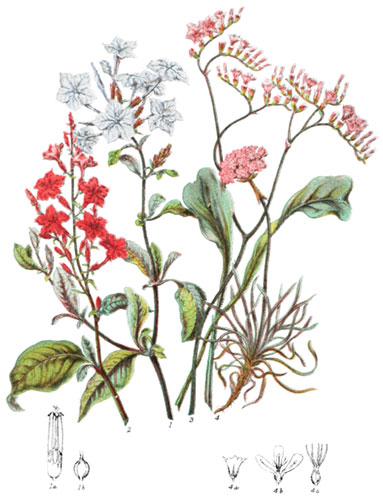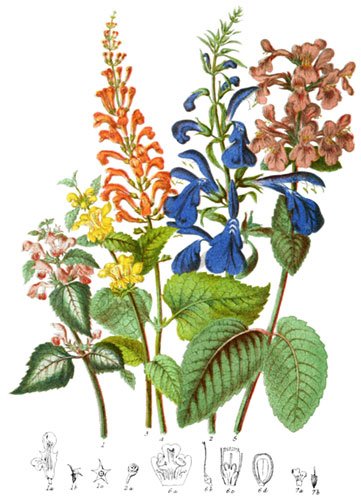Key characteristics
Trees, shrubs, and undershrubs; the leaves are evergreen, entire, whorled or opposite, without stipules. The inflorescence is variable, the flower-stalks generally have small bracts at their base. The calyx is four or five cleft, nearly equal, placed below the ovary, and persistent. The corolla is of one petal, four or five cleft, like the calyx, occasionally separable into four or five petals, regular or irregular. The stamens are equal in number to the divisions of the corolla, or twice as many; the anthers are two-celled, separate either at the apex or base by the disk, or secreting scales; the fruit is a capsule, many-celled, and many-seeded, opening in various ways, rarely a berry, as in Arbutus; the seeds are minute.
This extensive tribe may be divided into two sections. The true Heaths are amongst the most delicately beautiful of plants, but have scarcely any valuable properties; only a few of the succulent berries of some genera are eatabl. Rhododendron and its allies are noble ornaments of the countries where they grow naturally, and contribute highly to the embellishment of those to which they have been transplanted; in this section dangerous narcotic qualities prevail.
Select plants in this order
Not all plants listed are illustrated and not all plants illustrated are listed.
- Erica was known ony in its humble European species till towards the close of the last century, when vast numbers were discovered at the Cape of Good Hope by Francis Masson. The neatness of the foliage, and the graceful elegance of the flowers, which are of considerable duration, render them worthy of the skill which has made their cultivation so successful in England.
- Erica cinerea (1) is extremely abundant in many parts of Britain, combining with Calluna vulgaris, Ling or Heather, to adorn the barren commons and moors with brilliant purple flowers, affording food and shelter to birds, and thatch for the cabins of the peasants in the northern districts.
- E. tetralix (2) is a less commo species, of much beauty, although the flowers are confined to a small terminal cluster.
- Arbutus Unedo (4) seems to have attracted notice at an early period, having been known to and described by Dioscorides. It is one of the finest shrubs of southern Europe., and is also found in luxuriant growth on the limestone rocks about Killarney, in Ireland, whither it was probably conveyed from Spain. Although not a native of England, it flourishes remarkably well in the south parts of Hampshire and elsewhere, bearing both flowers and fruit during the autumn; the bark and leaves are astringent. In Corsica, a wine is prepared from the berries, but it is said to have narcotic properties.
- Rhododendron ferrugineum (5) is a striking ornament of Alpine regions, advancing to the extreme limits of woody vegetation; the bright red flowers of the Rose des Alpes frequently delight the mountain traveller when he meets with it on his solitary path, or it is brought to him as a humble offering by the peasants of the country. The wood furnishes the shepherds of the lofty summer pastures with their only fuel.
- R. hirsutum is another Alpine species.
- R. arboretum (6) is a splendid tree of forty feet in height, growing on the southern districts of the Himalayas, between 5000 and 8000 feet of elevation; it sometimes occurs in a broad belt on the slope of the mountain, and in March and April, when each branch is terminated with a cluster of the crimson flowers, it has a very magnificent aspect; the wood is much used by the natives, and a kind of jelly is made from the flowers.
- R. dauricum is an early flowering shrub of English gardens, introduced about seventy years ago from Eastern Asia, where it spreads over the Mongolian Deserts, and abounds around Lake Baikal, and in the fir-woods on the shores of the rivers.
- R. ponticum is supposed to have yielded the honey which Xenophon describes to have been so injurious to the Greeks in the celebrated retreat of the Ten Thousand, causing them to fall down after eating it, as if poisoned.
- R. lapponicum belongs to the Northern regions, and extends to the plains of the Arctic zone.
- Kalmia latifolia (7) inhabits rocks and sterile ground in North America; the flowers exude a deleterious kind of honey, and the leaves are poisonous to animals, but the Indians make use of the hard wood for various purposes; from the roots they also make dishes and other small articles.
- The different species of Azalea from Asia and North America afford hardy ornamental shrubs for gardens.
- On the mountains of the tropics, Befaria takes the place of Rhododendron, and covers the rocky slopes to the height of 10,000 feet.
- Humboldt discovered B. ledifolia on the Silla de Caraccas at 6000 feet; some species belong to the lower hills.
- The bright red berries of Gualteria procumbens contain an aromatic oil used medicinally in North America.
- G. hispida, the Wax-cluster of Tasmania, has white berries of an agreeable flavour.
- Andromeda is a genus belonging to Alpine regions and bogs; A. hypnoides extends over wide plains in Lapland.
- Ledum and others inhabit similar localities in North America.
Locations
This Tribe is dispersed in the greatest abundance in South Africa and North America; in Europe it is common, but limited to a few species; in South America it is found both within and beyond the Tropics; it abounds less in Northern Asia and India, and is alomst unknown in Australia. When found in Tropical regions, it exists only on mountains. Erica covers vast tracts at the Cape of Good Hope, to which by far the greater number of species especially belong. Befaria is peculiar to the mountains of South America.
Legend
- Erica cinerea, Five-leaved Heath. Britain.
- Stamen.
- Erica tetralix, Cross-leaved Heath. Britain.
- Stamen.
- Pistil.
- Erica ventricosa, Porcelain Heath. Cape of Good Hope.
- Arbutus Unedo, Strawberry Tree. S. Europe and Ireland.
- Rhododendron ferrugineum, Rusty-leaved Rhododendron. Switzerland.
- Stamen.
- Pistil.
- Rhododendron arboreum, Tree Rhododendron. Himalayas.
- Kalmia latifolia, Broad-leaved Kalmia. North America.
- Capsule of R. albiflorum.
Explore more
Posters
Decorate your walls with colorful detailed posters based on Elizabeth Twining’s beautiful two-volume set from 1868.
Puzzles
Challenge yourself or someone else to assemble a puzzle of all 160 botanical illustrations.
